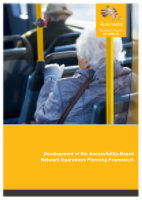Network

- Publication no: AP-R499-15
- ISBN: 978-1-925294-86-6
- Published: 20 November 2015
- PDF (free) Download
This report extends the Austroads network operation planning framework to address transport accessibility issues.
The extended framework itemises the general principles and steps in developing an accessibility-based network operation plan (NOP). The framework includes general guidance on accessibility metrics for employment, education, retail and recreation, health and community services, and freight. The framework was applied to the Burwood Heights Activity Centre (in Melbourne) to illustrate how the framework can be applied.
The report recommends that the general principles and key steps of the proposed accessibility-based NOP framework be incorporated in the Guide to Traffic Management. It also recommends that the framework be incorporated in the development of network operation plans, where appropriate.
To facilitate the application of the accessibility-based NOP, the development of a computer software application is recommended. The tool would assist planners to assess travel time and journey LOS gaps.
Austroads project NS2003: Requirements and Development of a NOP Tool
The SmartRoads tool, developed by VicRoads, has been adopted by a number of jurisdictions as the basis for network operation planning. As SmartRoads is applied in more varied context and as the application of network operation planning becomes more sophisticated, a need has been identified to develop the next generation tool. Austroads project NS2003 is an on-going project which will develop the business case and specifications for the next generation NOP tool (including the accessibility framework identified in this report).
- Summary
- 1. Introduction
- 1.1. Background
- 1.2. Purpose, Scope and Method of the Project
- 1.3. Structure of the Report
- 2. Need for Accessibility-Based Network Operation Planning
- 2.1. Accessibility Issues
- 2.2. Accessibility Factors and the Scope of a Network Operation Plan
- 2.2.1. Scale of Opportunities
- 2.2.2. Quantity of Travel
- 2.2.3. Quality of Travel
- 2.2.4. Nature and Constraints of Road Users
- 2.3. Scope of NOP in Addressing Accessibility Issues
- 3. Accessibility-Based Network Operation Planning Framework
- 3.1. Introducing Accessibility Considerations in NOP
- 3.2. Stages of the Accessibility-based NOP Framework
- 3.2.1. Network Operation and Accessibility Objectives
- 3.2.2. Road Use Priorities, Including Critical Routes for Accessibility
- 3.2.3. Network Performance
- 3.2.4. Operation Strategies
- 3.2.5. Network Management and Operation, and Network Improvement (Civil Works) Options Appraisal
- 3.2.6. Use and Implementation of Accessibility-based NOP
- 3.2.7. Evaluation of Plans: Accessibility Levels and Network Performance
- 3.3. Inputs, Processes and Outputs of the Framework Stages
- 3.4. Coordination of Accessibility and Operational Performance
- 4. Case Study 1: Neighbourhood NOP
- 4.1. Burwood Heights Activity Centre
- 4.2. Network Operation and Accessibility Objectives
- 4.2.1. Metropolitan and Neighbourhood Planning Principles
- 4.2.2. Accessibility Needs of Road Users
- 4.2.3. Accessibility Targets
- 4.3. Road Use Priorities and Critical Accessibility Routes
- 4.4. Network Performance
- 4.4.1. LOS Assessment
- 4.4.2. Accessibility Assessment
- 4.4.3. Operational Performance
- 4.5. Operation Strategies
- 4.6. Network Management and Operation, and Network Improvement Options
- 4.7. Application and Evaluation of the Accessibility-based NOP
- 4.8. Summary of Case Study
- 5. Case Study 2: Metropolitan NOP
- 5.1. Accessibility to Employment by Car
- 5.1.1. Network Operation and Accessibility Objectives
- 5.1.2. Accessibility-critical Routes
- 5.1.3. Network Performance
- 5.1.4. Operation Strategies
- 5.1.5. Network Management and Operation and Network Improvement Options
- 5.1.6. Implementation, Evaluation and Feedback
- 5.2. Freight Accessibility of BHAC
- 5.2.1. Network Operation and Accessibility Objectives
- 5.2.2. Accessibility-critical Routes
- 5.2.3. Network Performance
- 5.2.4. Operation Strategies
- 5.2.5. Network Management and Operation, and Network Improvement
- 5.2.6. Implementation, Evaluation and Feedback
- 5.3. Summary of Case Study
- 6. Conclusions and Recommendations
- References
- Appendix A Examples of Accessibility Indicators
- Appendix B Freight, and Health and Community Service Accessibility
- B.1 Stakeholder Interviews
- B.2 Literature Review
- B.3 Freight Accessibility Findings
- B.4 Health and Community Services Findings
- Appendix C Mobility Performance Gap: Network Efficiency
- Appendix D Travel Speed LOS and Congestion LOS on Freight Routes for BHAC
